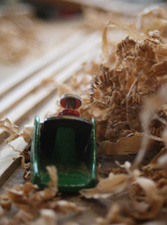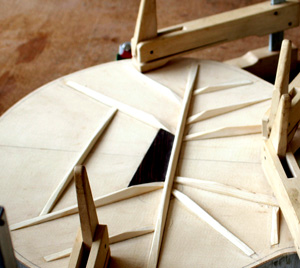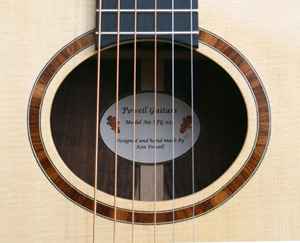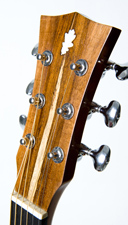Design & Construction

Many contradicting articles have been written on the design of the steel string guitar as we know it today and it has taken many years to move away from the 100 year old bracing designs made popular by all of the “big” guitar companies who concentrate on production and cost per unit. When you start to examine how a guitar top reacts to the energy of a plucked string, you start to realise the standard bracing pattern can be very inefficient. The standard X although very strong restricts the “rocking” action of the bridge. After studying many bracing designs the result from well made guitars is that they all give acceptable results, so why change them or be different?
The full potential and evolvement of the guitar has not yet been fully realised and the string energy efficiency still needs further exploration. Rubbish I hear you say?
Excellent results are obtained using a bracing design developed by myself through a number of instruments achieving great projection and excellent tone.
Like most luthiers passionate about their work I am still learning, still developing my designs and improving my skills with each new instrument.

The bridge design works very well and also fits nicely with the aesthetics and ergonomics of the overall design. It follows theories about string vibration and bridge movement without looking too obscure or too traditional. The bridge is an external brace and this should be taken into account when designing the top. It’s function is not only to provide a place to attach the strings but also to provide a structural and vibrational brace which is very important in transmitting the string energy to the top and rest of the instrument.

A variety of neck widths and profiles are on offer to suit an individuals playing style or personal preference. If you are not sure, then advise and guidance is provided to point you in the right direction. Some people choose a guitar because it feels right in the hand. Why not choose a guitar that you like and have the playability made to fit you.
The oval hole positioned at the 19th fret gives that extra vibrating area and increases the instruments sweet spot. Some guitarists prefer more frets and a cut away. I have observed many fine and professional solo players who rarely if indeed visit the dusty end of the fret board in many complex arrangements.

Elegant decoration, top quality woods, and modern neck profiles for easy playing are all standard features.

Simple is definitely better! The reward at the end of the build is a guitar that sounds and plays like no other, an instrument worthy of keeping for a lifetime, then handing down to the next generation of players.
